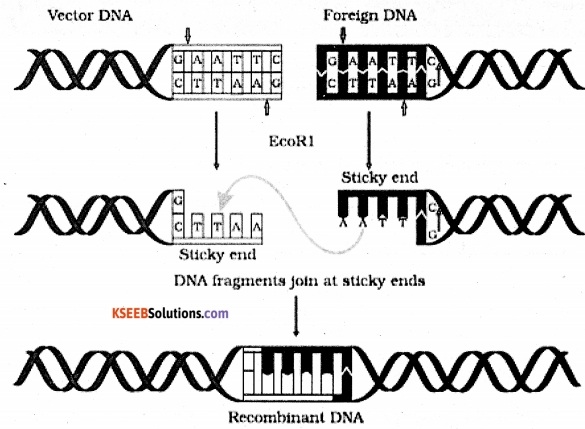You can Download Chapter 11 Biotechnology: Principles and Processes Questions and Answers, 1st PUC Biology Question Bank with Answers, Karnataka State Board Solutions help you to revise complete Syllabus and score more marks in your examinations.
Karnataka 2nd PUC Biology Question Bank Chapter 11 Biotechnology: Principles and Processes
2nd PUC Biology Biotechnology: Principles and Processes NCERT Text Book Questions and Answers
Question 1.
Can you list 10 recombinant proteins which are used in medical practice? Find out where they are used as therapeutics (use the internet).
Answer:
- Human Insulin (Humulin) – Treatment of Diabetes Type 1
- Human Growth Hormone (HGH) – Replacement of deficient hormone in short stature persons.
- Calcitonin – Treatment of rickets.
- Chorionic Gonadotropin – Treatment of infertility.
- Erythropoietin – stimulates erythrocyte formation in anaemics.
- Tissue Plasminogen Activator – Dissolves blood clots after stroke and heart attack.
- Blood Clotting factors VIII and IX – Replacement of clotting factors missing in haemophitra A or B patients.
- Platelet Growth Factor – Stimulation of wound healing.
- Interferon (α,β,γ) – Treatment of viral infection and cancer.
- Interleukins – Enhancing activity of immune system.
- Vaccines – Preventing diseases like herpes, hepatitis B, etc.,
Question 2.
Make a chart (with diagrammatic representation) showing a restriction enzyme, the substrate . DNA on which it acts, the site at which it cuts DNA and the product it produces.
Answer:
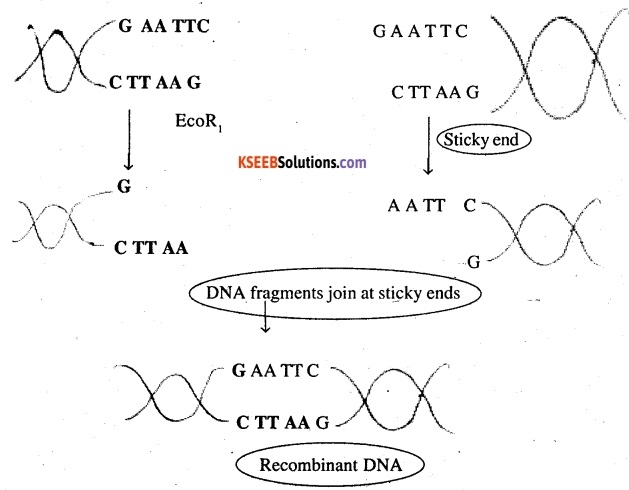
Question 3.
From what you have learnt, can you tell whether enzymes are bigger or DNA is bigger in molecular size? How did you know?
Answer:
DNA molecules are biggest biomolecules containing number of genes. A gene operates through synthesis of polypeptide. An enzyme is formed of one or few polypeptides. It is always smaller than DNA which contains hundreds of genes.
Question 4.
What would be the molar concentration of human DNA in a human cell? Consult your teacher.
Answer:
Calculate molar concentration by finding weight of DNA in a cell and weight of whole cell.
Question 5.
Do eukaryotic cells have restriction endonucleases? Justify your answer.
Answer:
No. Eukaryotic cells do not have restriction endonucleases. Restriction endonucleases are present in bacteria. They protect bacteria from viral attack by disintegrating viral DNA without harming bacterial genome which has methylation of sensitive sites.
![]()
Question 6.
Besides better aeration and mixing properties, what other advantages do stirred tank bioreactors have over shake flasks?
Answer:
Foam control system, a temperature control system, pH control system and sampling port to take small volume of culture periodically are some other advantages of stirred tank bioreactors.
Question 7.
Collect 4 examples of palindromic DNA sequences by consulting your teacher. Better try to create a palindromic sequence by following base-pair rules.
Answer:
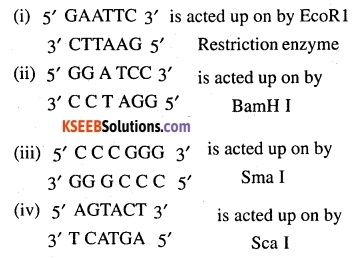
Question 8.
Can you recall meiosis and indicate at what stage a recombinant DNA is made?
Answer:
Pachytene of meioses I
Question 9.
Can you think and answer how a reporter enzyme can be used to monitor the transformation of host cells by foreign DNA in addition to a selectable marker? Ans: A selectable marker helps to identify transformed host cells and non transformed cells will be eliminated and only transformed cells will grow. Whereas reporter gene is the one whose phenotypic expression can be monitored and thus it reports about activity or change in advance of the effect of modification, in addition to eliminating non transformed cells by selectable markers. HLDescribe briefly the followings:
(a) Origin of replication
(b) Bioreactors
(c) Downstream processing
Answer:
(a) Origin of Replication (Ori):- It is DNA sequence which is specialised to initiate replication Bacterial chromosomes and plasmids possess a single origin of replication Eukaryote chromosomes have a number of origin of replication. Replication proceeds bidirectional from the site of origin of replication. The sequence also possesses nearby replication control which determines the number of copies it would form. Therefore the selected plasmid should have an origin of replication that supports high copy number.
(b) Bio Reactor:
Bio reactor used in biotechnology is generally 100-1000 litre cylindrical metal. container with a curved base to facilitate mixing of contents. The culture medium containing all nutrients, salts vitamins, hormones etc. is added along with inoculum of transformed cells with recombinant DNA. A stirrer helps in mixing and optimum availability of nutrients to culture cells. Supply of oxygen is maintained if the cells function better under aerobic conditions. Foam is kept under control. Gadgets are attached for knowing temperature and pH of the contents. Corrections are made when required. There is a sampling port where small volume of culture can be withdrawn to know the growth of cells and concentration of extractable product.
(c) Downstream processing:
It is the recovery of product from fully grown genetically modified cells, its purification and preservation. It is carried out after the sampling report indicates the completion of biosynthetic phase and presence of optimum product in the cells. After leaving a part of cellular mass of inoculum, the rest is crushed and chemically treated to separate the product. The separated product is purified and then formulated with suitable preservatives. Clinical traits are carried out to know its used and any immediate or long term adverse effect. Every batch of the product has to pass through strict quality control testing. Of course, the procedure and vigour of downstream processing and quality control varies from product to product.
Question 11.
Explain briefly
(a) PCR
(b) Restriction enzymes and DNA
(c) Chitinase
Answer:
(a) PCR:
PCR stands for Polymerase chain reaction. In this reaction multiple copies of the gene (DNA) of interest is synthesized in vitro using two sets of primers (small chemically synthesized oligonucleotides that are complementary to the region of DNA) and the enzyme DNA polymerase. The enzyme extends the primers using the nucleotides provided in the reaction and the genomic DNA as template. Then the process of replication of DNA is repeated many times i.e. one billion copies are made.
(b) Restriction enzyme:
The enzymes which are responsible for ‘ restricting the growth of bacteriophage in Escherichia coli are called restriction enzymes. One of this enzyme is added to the methyl groups of DNA, while the other cut DNA. This enzyme is known as restriction endonuclease enzyme. The first restriction endonuclease is Hind II. Now more than 900 restriction enzymes have been isolated from over 230 strains of bacteria.
(c) Chitinase:
It is an enzyme obtained from fungus Trichoderma which is specialised to digest chitin of fungal cell walls. The enzyme is used both as an effective fungicide as well as dissolving fungal cell walls to obtain their protoplasts for separation of DNA is genetic engineering.
Question 12.
Discuss with your teacher and find out how to distinguish between
(a) Plasmid DNA and Chromosomal DNA
(b) RNA and DNA
(c) Exonuclease and Endonuclease
Answer:
(a) Plasmid DNA and Chromosomal DNA
| Plasmid DNA | Chromosomal DNA |
| (i) It is extra nuclear DNA | It is nuclear DNA |
| (ii) It caries nonvital genes | It possesses vital genes |
| (iii) A bacterial cell may carry one to several plasmid DNAs. | A bacterial cell carries only one chromosomed DNA |
(b) RNA and DNA
| RNA | DNA |
| (i) It is ribo nucleic acid | Deqxy ribo nucleic acid |
| (ii) It is single strandred | Double standard |
| (iii) RNA produced from DNA template | Parental DNA acts as DNA template |
| (iv) Nitrogen base Uracil in present instead of thymine, pairs with adenine. | Thymine pairs with adenine |
(c) Exonuclease and Endonuclease
| Exonuclease | Endonuclease |
| (i) It breaks DNA from ends | It cuts DNA from inside |
| (ii) The separated fragments are small nucleotides | These separated fragments are generally large sized |
| (iii) The separated fragments cannot be used in genetic engineering | The desirable separated fragments are used in genetic engeneering |
2nd PUC Biology Biotechnology: Principles and Processes Additional Questions and Answers
2nd PUC Biology Biotechnology: Principles and Processes One Mark Question
Question 1.
Expand
(i) PCR
(ii) Bt
Answer:
(i) PCR – Polymerase chain reaction
(ii) – Bacillus thurigenesis.
Question 2.
What is biotechnology?
Answer:
It is a branch of science that deals with techniques of using live organisms or enzymes from organisms, to produce products and processes useful to humans.
Question 3.
What is a plasmid? (Delhi 2008)
Answer:
A plasmid is an autonomously replicating circular extra chromosomal DNA found in bacterial cell.
![]()
Question 4.
Name the first restriction endonuclease discovered.
Answer:
Hind II is the first restriction endonuclease.
Question 5.
Name the technique used for separating DNA fragments in the latoratory
Answer:
Electrophoresis. (Dehli 2005)
Question 6.
What acts as “molecular scissors” in biotechnology.
Answer:
Restriction enzyme “endonuclease” acts as molecular scissors in biotechnology.
Question 7.
Write the function of restriction enzyme in bacterial cell?
Answer:
Responsible for restricting the growth of bacteriophage.
Question 8.
Name the substance used as the medium in gel electrophoresis.
Answer:
Agarose is the substance used in gel electrophoresis.
Question 9.
Why are plasmids and bacteriophages commonly used as cloning vectors?
Answer:
Plasmids and bacteriophages have the ability to replicate within bacterial cells independently of the chromosomal DNA.
Question 10.
Name the enzymes used to digest the cell wall of bacteria and fungi for genetic engineering.
Answer:
- Bacteria -Lysozyme
- Fungi – Chitinase
Question 11.
What is downstream processing?
Answer:
Downstream processing is the recovery of product from the fully grown genetically modified cells, its purification and preservation
Question 12.
Name any 4 products of Recombinant technology.
Answer:
Human insulin (Humulin). Human growth hormone (HGH) Chorionic gonadotropin Blood dotting factors VIII and IX Erythropoeitin Platelet growth factor Interferon (α,β,γ) (any 4)
Question 13.
What is gene therapy?
Answer:
It is the replacement of a defective gene by normal healthy and functional gene. This method helps to overcome the effect of various disorders like sickle cell anaemia, alkaptonuria, SCID, colour blindness etc.
Question 14.
Why does a cloning vector requires a selectable marker?
Answer:
Because it helps in identifying and selecting the recombinants and eliminating the non-recombinants.
Question 15.
What is amplification.
Answer:
It is the process of making multiple copies of gene/DNA segments of interest.
Question 16.
What is recombinant protein?
Answer:
It is biochemical compound or useful protein produced inside the heterologous host cell by recombinant biotechnology method.
Question 17.
What is bioreactor or fermenter?
Answer:
It is a container in which biochemical process is carried out by using living cells and their growth medium.
Question 18.
What meant by bioconversion?
Answer:
It is the process by which raw materials are biologically converted into specific products using microbes, plant or animal cells and or their enzymes.
Question 19.
Why are antibiotic resistance genes used as selectable markers for E.Coli?
Answer:
Since E.Coli doesn’t have any of antibiotic resistance genes, antibiotic resistance genes are used from outside as selectable marker.
2nd PUC Biology Biotechnology: Principles and Processes Two Marks Questions
Question 1.
Name the scientists who constructed recombinant DNA. Name the bacterium from which they isolated the gene.
Answer:
Stanley Cohen and Herbert Boyer were the first to construct a recombinant DNA. They isolated the gene from the bacterium. Salmonella typhimurium.
Question 2.
Few gaps have been left in the following table showing certain terms and their meanings, fill up the gaps.
Term Meanings
(i) ………….. Non-coding sequence in eukaryotic DNA
(ii) ………….. Technique used in solving paternity disputes
(iii) Restriction endonuclease …………..
(iv) Plasmids …………..
(v) Transgenics …………..
(vi) Nucleotide sequences with single base deficiencies …………….
![]()
Question 3.
Name the particular technique in biotechnology whose steps are shown in figure use the figure to summaries the technique in three steps.
Answer:
- Template stand
- DNA fingerprinting
- Extranuclear DNAs
- Organisms having genes of other organisms obtained through genetic engineering.
- Single nucleotide polymorphism. (SNPs)
Question 3.
Name the particular technique in biotechnology whose steps are shown in figure use the figure to summaries the technique in three steps.
Answer:
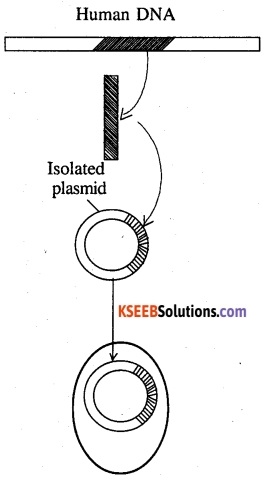
(a) Recombinant technology
(b)
- Cutting and isolation of human gene
- Incorporation of human gene into plasmid to produce recombinant DNA or plasmid
- Incorporation of recombinant plasmids into bacterium to obtain gene product
Question 4.
Refer the diagram and answer the following
(i) From what T1– plasmid is obtained?
(ii) Name the enzyme which is involved in step I
(iii) What happens in step II
(iv) The plant produced is called hybrid or transgenic
(v) Will the plant produced have other genes along with desired genes? Yes or No explain.
Answer:
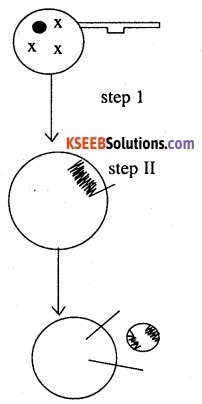
(i) Agrobacterium tumefaciens
(ii) Restriction endonuclease
(iii) Incorporation of genes in T1 plasmid in the region of T-DNA.
(iv) Transgenic
(v) Yes. Selectable marker gene which is often an antibiotic resistance gene
Question 5.

Study the linking of DNA fragments shown above
(i) Name “a” DNA and “b” DNA
(ii) Name the restriction enzymes that recognizes this palindrome
(iii) Name the enzyme that can link these two DNA fragments (CBSE 2008)
Answer:
(i) (a) – vector DNA
(b) – foreign DNA
(ii) EcoRI
(iii) DNA ligase
Question 6.
Explain the importance of
(a) Ori
(b) amp R and
(c) rop in E. Coli vector shown below (CBSE 2008)
Answer:
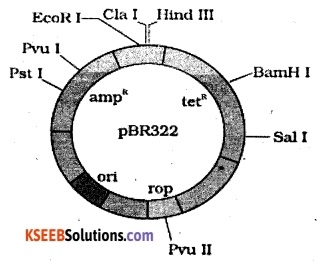
- Ori – Origin of replication
- amp R – ampicillin antibiotic resistance gene
- rop – gene that produces proteins involved in the replication of plasmid.
Question 7.
An interesting property of restriction enzymes is molecular cutting and pasting Restriction enzymes typically recognize a symmetrical
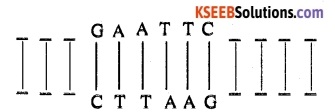
Notice that the top strand is the same as the bottom strand but reads backward. When the enzyme cut the strand between G and A, it leaves overhanging chains

(A) What is the symmetrical sequence of DNA known as?
(B) What is the significance of these over hanging chains?
(C) Name the restriction enzyme that cuts the strand between G and A.
Answer:
(A) Palindromic sequence
(B) sticky ends
(C) Eco RI
Question 8.
Name any two cloning vectors. Describe the features required to facilitate cloning into a vector.
Answer:
a.
- Plasmid
- Viruses
b.
- Presence of origin of replication (Ori)
- Selectable marker for identifying recombinant from non-recombinant
- Single site recognition site for cloning
Question 9.
What are cloning vectors? What functions do these vectors perform?
Answer:
Cloning vectors are those organisms on their DNAs which can multiply independently of the host DNA and increase their copy number along with the alien DNA attached to them. Functions are:
- They help in linking the foreign/alien DNA with that of the host
- They also help in the selection of recombinants from non-recombinants
Question 10.
Name the organism from where the thermostable DNA polymerase is isolated. Write the importance of this enzyme is genetic engineering.
Answer:
Thermits acquaticus. This enzyme can remain active even during the high temperature induced denaturation of the double stranded DNA occurs.
Question 11.
How do “Ori” and “Cloning site” facilitate cloning into a vector? (AI 2008)
Answer:
“Ori” is a specific sequence of DNA, where replication occurs; the alien DNA must be linked to it, if it has to replicate. The restriction site where a foreign DNA is linked is called “cloning site”.
Question 12.
List 4 steps to isolate DNA from a bacterial cell. (AI 2008, 2009)
Answer:
- The bacterial cell is treated with lysozyme to break open the cell.
- The RNAs associated with the DNA are removed by treatment with ribonuclease (RNAases)
- The proteins are removed by treatment with proteases
- The purified DNA is precipitated with chilled ethanol.
2nd PUC Biology Biotechnology: Principles and Processes Three Marks Question
Question 1.
What are restriction enzymes? Describe the naming of the restriction enzyme.
Answer:
Restriction enzymes are those enzyme which are present in bacterial cells as a defence mechanism to restrict the growth of bacteriophage, by cutting the DNA at specific sites.
- The first letter of the name comes from the genus of the prokaryote.
- The second and third letters come from the name of the species of the cell from where it is obtained.
- The fourth letter comes from the strain of the prokaryote.
- The Roman numbers following these 4 letters indicate the order in which enzymes were isolated from the strain of the bacterise.
e.g. E Coli RI is isolated from Escherichia coli strain RY13. The letter ‘R” stands for the strain.
![]()
Question 2.
Represent diagrammatically the E Coli cloning vector pBR 322 showing the restriction site.
Answer:
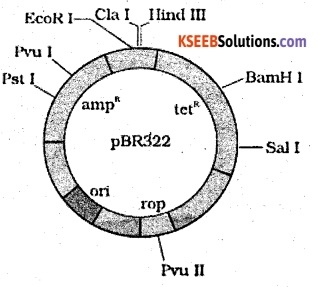
Question 3.
Draw a labelled diagram of a sparged stirred tank bioreactor.
Answer:
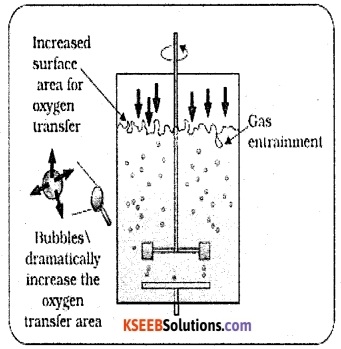
Question 4.
Read the following base sequence of a certain DNA strand and answer the questions that follow.

(i) What is called “Palindromic sequence” in a bNA?
(ii) Write the Palindromic nucleotide sequence shown in the DNA strand given and mention the enzyme that will recognise such a sequence.
(iii) State the significance of enzymes that identify palindromic nucleotide sequences.
(AI – 2008)
Answer:
(i) A palindromic sequence of DNA is a sequence of base pairs that reads the same on the two strands, when orientation of reading is kept the same, i.e. in the 5′ → 3′ direction.
(ii) 5′ GAA TT C – 3′
3′ CTTA AG – 5′
This sequence is restricted by the restriction enzyme Eco RI
(iii) The enzyme that identifies the palindromic nucletide sequence cut the strands between the same 2 bases, more often producing sticky ends; hence they are useful in the formation of recombinant DNA.
2nd PUC Biology Biotechnology: Principles and Processes Five Marks Question
Question 1.
Describe in detail the components of a simple stirred tank bioreactor along with a labelled diagram.
Answer:
A stiered tank bioreactor is usually a cylindrical vessel with a curved base to facilitate the mixing of the content. The stirrer facilitates even mixing and oxygen availability through out the bioreactor.
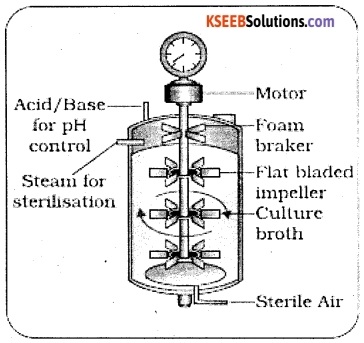
The bioreactor has an agitator system, an oxygen delivery system along with a foam control system, a temperature control system, pH control system and sampling ports to remove small volumes of culture periodically.
It provides optimum growth conditions of pH, temperatures, substrate, oxygen etc. for achieving the desired products.
Question 2.
In a bacterial culture, some of the colonies produced blue colour in the presence of a chromogenic substrate and some did not due to the presence or absence of an insert (r DNA) in the coding sequence of (3 – galactosidase).
(a) Mention the mechanism and the steps involved in the above experiment.
(b) How is it advantageous over simultaneous plating on two plates having different antibiotics.
Answer:
(a) The mechanism involved is called insertional inactivation, the phenomenon in which the enzyme becomes inactivated when a recombinant DNA is inserted with in the coding sequence of that enzyme.
Steps in process:
- A recombinant DNA is inserted into the DNA sequence coding for the enzyme galacto sidase, it results in the inactivation of the enzyme.
- In case of the recombinants, when the plasmid has an insert, there is no blue colour produced in the presence of a chromogenic substrate in the medium.
- In the case of nonrecombinants/non- tranforments i.e. when the plasmid has no insert, a blue colour is produced in the presence of a chromogenic substrate in the medium.
(b) Advantage:
Simultaneous plating method is quite cumbersome as it requires two plates where as this method is simple and easy.
![]()
Question 3.
(a) If the restriction enzyme has to cut a DNA, the DNA must be in pure form, i.e. free from the associated RNA and proteins. How is it achieved.
(b) Represent only diagrammatically the steps in the recombinant DNA (r DNA) technology.
Answer:
(a) The RNAs are removed by using enzymes called ribonucleases (RNases) The proteins are removed by using enzyme proteases.
(b)
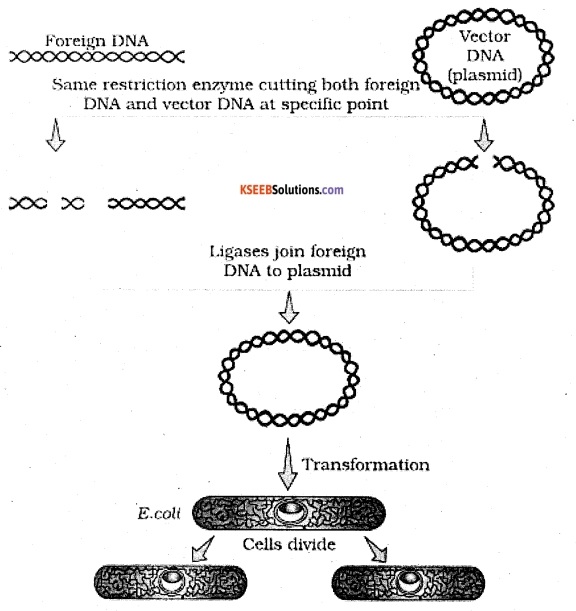
Question 4.
(a) Show only diagrammatically the three steps in the polymerase chain reaction,
(b) How is repeated amplification achieved using this method?
Answer:
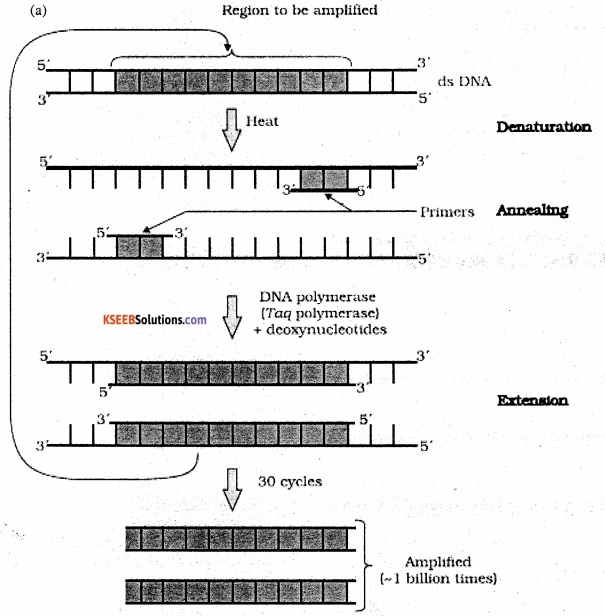
(b) Repeated amplification is achieved by the use of a thermostable DNA polymerase, it is isolated from the bacterium Thermus aquaticus. It remains active during the high temperature used for denaturation of the double-stranded DNA.
Question 5.
Make a diagrammatic representation of showing a restriction enzyme, the substrate DNA on u which it acts the site at which it cuts DNA and the product it produces.
Answer:
